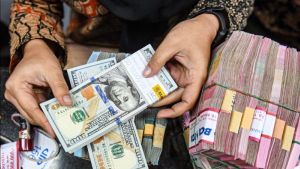JAKARTA - The Composite Stock Price Index (JCI) fell 3.40 percent or 248.47 points to 7,059.65 until the end of trading on the Indonesia Stock Exchange (IDX).
Furthermore, the total volume of exchange transactions reached 24.4 billion shares with a transaction value of IDR 13.75 trillion.
A total of 592 stocks fell, 62 stocks rose and 134 stocks were stagnant.
The entire sectoral index has fallen along with the JCI. The energy sector fell 4.94 percent, the raw goods sector fell 4.69 percent, the transportation and logistics sector plunged 4.23 percent, the industrial sector weakened 3.73 percent, and the infrastructure sector fell 3.15 percent.
Furthermore, the property and real estate sectors fell 3.05 percent, the technology sector weakened 2.92 percent, the financial sector fell 2.69 percent, the non-primary consumption goods sector fell 2.47 percent, the primary consumption goods sector weakened 1.77 percent, the health sector fell 0.72 percent.
Phintraco Sekuritas analyst Alrich Paskalis Tambolang said the weakening of the JCI was caused by domestic and foreign factors.
Alrich said that in terms of relatively solid domestic economic conditions, in the second quarter of 2024, Indonesia's economy grew 5.05 percent (yoy).
Despite the quarter-to-quarter decline, household consumption still grew by 4.93 percent and investment increased to 4.43 percent.
"At this time the Indonesian economy is still under the assumption of the State Budget in the range of 5 percent. This domestic economic condition maintains the potential for further weakening in the JCI today," he explained to VOI, Monday, August 5.
Alrich explained that foreign sentiment stems from labor data in the United States has decreased in recent months, where last week the Initial Jobless Claims increased by 249,000, the largest addition since 2023.
"Followed by PMI Manufacturing ISM, it fell to 46.8 in July 2024 from 48.5 in June 2024, triggering concerns about the economic recession in the United States," he said.
Alrich explained, after Nikkei previously experienced the largest daily weakening since the Black Monday incident in 1987 along with the decline in Japanese government bond yields with yields on 10-year JGB benchmarks falling below the level of 1 percent and hitting its lowest level since June 20.
"This is an investor's response to the BoJ action by increasing the interest rate rate from 0.1 percent to 0.25 percent on Wednesday, July 31 and reducing bond purchases by BoJ," he said.
Head of Research Kiwoom Sekuritas, Sukarno Alatas said the decline in today's index was in line with other Asian exchanges, due to concerns about the recession in the US, the world's largest oil consumer, offset by supply risks arising from geopolitical tensions in the Middle East.
"Friday's data show a sharp slowdown in employment growth in the US, an increase in unemployment, and slower wage growth," he told VOI, Monday, August 5.
In addition, Sukarno conveyed that other sentiments came from the manufacturing sector of China unexpectedly experiencing contraction.
Plus the negative sentiment from BoJ which raised the interest rate to the level of 0.25 percent from 0.10 percent.
"Indeks nikei plunged as Japanese stocks followed losses on Wall Street driven by concerns over the US recession and disappointing profits from major tech companies," he added.
According to Sukarno, in the future the JCI will still have opportunities to improve when the pressure is low. Although in the short term, the JCI has broken down support for the sideways area and has been said to have entered a downward trend.
Sukarno explained that the sentiment of domestic economic growth in the midst of the threat of a recession in the United States could be the resilience of the index amid negative external sentiment.
"The latest Gdp growth in the second quarter managed to grow (QoQ) even though it was judged that (yoy) growth was slowing down, but the result was above market expectations," he explained.
SEE ALSO:
Therefore, Sukarno said that in the future there will be technical rebound opportunities and after that the index movement will continue the medium-term sideways trend and after that the opportunity will increase when the Fed's opportunity can reduce the interest rate in September.
"Currently, the prediction is that it can continue to go down to the next support level in the area of 6,950 (FR 61.8 percent) - 6,968 6,987 (gap area)," he concluded.
The English, Chinese, Japanese, Arabic, and French versions are automatically generated by the AI. So there may still be inaccuracies in translating, please always see Indonesian as our main language. (system supported by DigitalSiber.id)
















